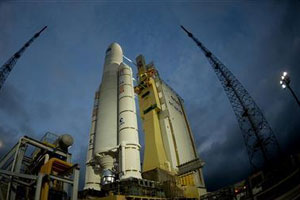
The September 22 launch of Indian communication satellite GSAT-10 has been delayed one week following the discovery of a damaged hose connecting the launch vehicle to its launch pad.
“While carrying out inspections the Arianespace has found that the air hose connecting the launch pad and the vehicle had a small damage,” said Indian Space Research Organization (ISRO) chairman K Radhakrishnan. “When such damage occurs some small particles of dust come out. We suspect that one gram of dust particle could have gone inside.”
GSAT-10 is a 3400 kg satellite carrying C and Ku band transponders as well as India’s third GPS Aided GEO Augmented Navigation (GAGAN) payload. GAGAN is a regional effort to boost navigation capability via incorporation of local reference stations. The system is expected to improve airplane navigation, providing visibility to 3m. The first GAGAN payload was launched in 2010 aboard the GSAT-4 satellite that failed to reach orbit when its Geosynchronous Satellite Launch Vehicle (GSLV) malfunctioned. The second successfully launched with GSAT-8 aboard an Ariane 5 in 2011.
The GSLV, India’s homegrown expendable launch vehicle, has yet to live up to its promise, most recently being responsible for indefinite delays in India’s human spaceflight endeavours. A recent five year plan for ISRO did not include human spaceflight goals. While indicating that manned flight would not take place before 2017 at the earliest, Radhakrishnan noted that existing launch vehicle GSLV-Mk II is not ideal for manned flight even without regard for its recent failures, since it could only accomodate a crew of two. Instead, ISRO intends to develop a new iteration. “We feel GSLV-Mk III would be a better vehicle,” he said.
Arianespace is taking corrective action to get GSAT-10’s Ariane 5 back in business, after which, Radhakrishnan says, further testing will be conducted. “We need to carry out two important tests before the launch,” the chairman said. “One is the endurance test on the fuel booster turbo pump and the other in which the cryogenic engine will ignite in high altitude vacuum condition.”
If an upcoming review by Arianespace goes well, the GSAT-10 launch will proceed to launch from Kourou, French Guiana on September 29.
Below, a report on the April 2010 GSLV failure that is partially repsonsible for delays in India’s human spaceflight initiative:

















































































































![A trajectory analysis that used a computational fluid dynamics approach to determine the likely position and velocity histories of the foam (Credits: NASA Ref [1] p61).](https://www.spacesafetymagazine.com/wp-content/uploads/2014/05/fluid-dynamics-trajectory-analysis-50x50.jpg)



Leave a Reply